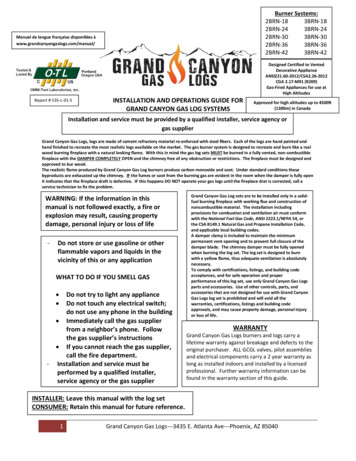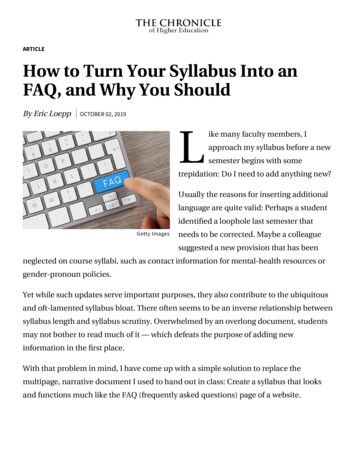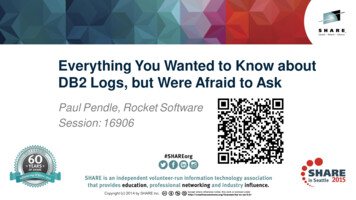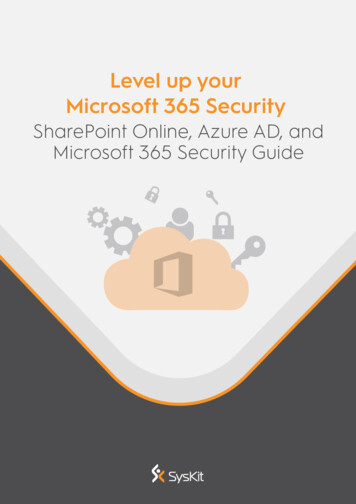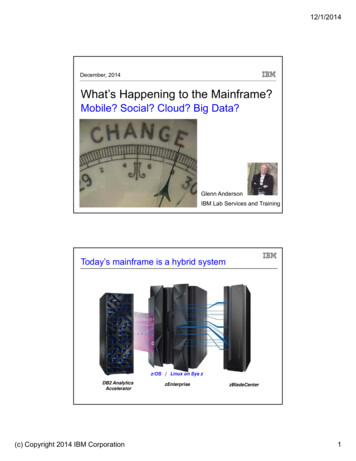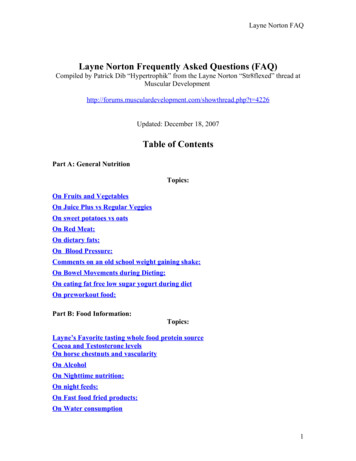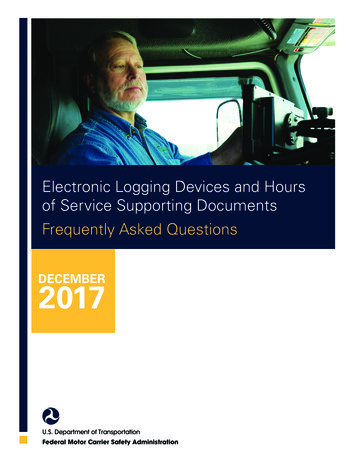
Transcription
Electronic Logging Devices and Hoursof Service Supporting DocumentsFrequently Asked QuestionsDECEMBER2017
Table of ContentsGeneral Information about the ELD Rule . . .Page 1ELD Exemptions . . Page 3Voluntary Usage and Compliance Phases . . . Page 5Supporting Documents . . Page 6Editing and Annotations . . Page 7Harassment . . Page 10ELD Functions . . . Page 11ELD Data Transfer . Page 13ELD Malfunctions and Data Diagnostic Events . Page 14ELD Accounts . . Page 16ELD Registration and Certification . . Page 17Differences between AOBRDs and ELDs. Page 18Differences between AOBRDs and Logging Software Programs . . Page 19Specialty Operations . . . . Page 19ELD Technical Specifications . . . Page 20ELD Manufacturer Compliance . Page 21Automatic On-Board Recording Device (AOBRD) . . Page 21
General Information about the ELD Rule1. What are the key requirements of the Electronic Logging Device (ELD) rule?The ELD rule: Requires ELD use by commercial drivers who are required to prepare hours-of-service (HOS) recordsof duty status (RODS). Sets ELD performance and design standards, and requires ELDs to be certified and registeredwith FMCSA. Establishes what supporting documents drivers and carriers are required to keep. Prohibits harassment of drivers based on ELD data or connected technology (such as fleetmanagement system). The rule also provides recourse for drivers who believe they havebeen harassed.2. What is the mandate in the Moving Ahead for Progress in the 21st Century Act (MAP-21) for theElectronic Logging Device (ELD) rule?Section 32301(b) of the Commercial Motor Vehicle Safety Enhancement Act, enacted as part of MAP-21,(Pub. L. 112-141, 126 Stat. 405, 786-788, July 6, 2012), mandates the ELD rule. It calls for the Secretaryof Transportation to adopt regulations requiring ELD use in commercial motor vehicles (CMVs) involved ininterstate commerce, when operated by drivers who are required to keep records of duty status (RODS).3. Who must comply with the electronic logging device (ELD) rule?The ELD applies to most motor carriers and drivers who are currently required to maintain records of dutystatus (RODS) per Part 395, 49 CFR 395.8(a). The rule applies to commercial buses as well as trucks, and toCanada- and Mexico-domiciled drivers.The ELD rule allows limited exceptions to the ELD mandate, including: Drivers who operate under the short-haul exceptions may continue using timecards; they are notrequired to keep RODS and will not be required to use ELDs. Drivers who use paper RODS for not more than 8 days out of every 30-day period. Drivers who conduct drive-away-tow-away operations, in which the vehicle being driven is thecommodity being delivered. Drivers of vehicles manufactured before 2000.4. What electronic logging device (ELD) user documentation must be onboard a driver’s commercialmotor vehicle?Beginning on December 18, 2017, a driver using an ELD must have an ELD information packet onboard thecommercial motor vehicle (CMV) containing the following items:1. A user’s manual for the driver describing how to operate the ELD;2. An instruction sheet describing the data transfer mechanisms supported by the ELD andstep-by-step instructions to produce and transfer the driver’s hours-of-service records to anauthorized safety official;3. An instruction sheet for the driver describing ELD malfunction reporting requirements andrecordkeeping procedures during ELD malfunctions; and4. A supply of blank driver’s records of duty status (RODS) graph-grids sufficient to record thedriver’s duty status and other related information for a minimum of 8 days.Prior to December 18, 2017, FMCSA recommends that drivers have the user’s manual, malfunctioninstruction sheet, and graph-grids.5. Can the ELD information packet be in electronic form?Yes. The user’s manual, instruction sheet, and malfunction instruction sheet can be in electronic form. Thisis in accordance with the federal register titled “Regulatory Guidance Concerning Electronic Signatures andDocuments” (76 FR 411).1
6. Can an electronic logging device (ELD) be on a smartphone or other wireless device?Yes. An ELD can be on a smartphone or other wireless device if the device meets the ELD rule’stechnical specifications.7. Can a driver use a portable electronic logging device (ELD)?Yes. A driver may use a portable ELD. A portable ELD must be mounted in a fixed position duringcommercial motor vehicle (CMV) operation (CMV) and visible to the driver from a normal seated drivingposition. This information can be found in the ELD Rule section 395.22(g).8. How long must a motor carrier retain electronic logging device (ELD) record of duty status(RODS) data?A motor carrier must retain ELD record of duty status (RODS) data and back-up data for six months.The back-up copy of ELD records must be maintained on a device separate from that where originaldata are stored. Additionally, a motor carrier must retain a driver’s ELD records in a manner that protectsdriver privacy.9. What electronically transferred data from electronic logging devices (ELDs) will be retained byFederal Motor Carrier Safety Administration (FMCSA) and other authorized safety officials?FMCSA will not retain any ELD data unless there is a violation.10. What is the carrier’s responsibility in ensuring that they are using a registered device?The motor carrier is responsible for checking that their device is registered. This includes checking both theregistration and revocation list periodically. The list of registered and revoked ELDs can be found on thefollowing link: https://3pdp.fmcsa.dot.gov/ELD/ELDList.aspx.In the event that an ELD is removed from the registration list, FMCSA will make efforts to notify the publicand affected users. Motor carriers and drivers are encouraged to sign-up for ELD updates to receivenotifications on when an ELD has been listed on the Revocation List.11. How will the ELD display screen or printout reflect special driving categories; yard moves andpersonal conveyance?While not required, if the motor carrier configured the driver user account to authorize a special drivingcategory, then the graph-grid will overlay periods using a different style line (such as dashed, dotted line, orshading) in accordance with section 4.8.1.3(c)(1) of the ELD Functional Specifications. The appropriateabbreviation must also be indicated on the graph-grid.If the motor carrier does not configure the driver user account to authorize special driving categories, thenthe driver must annotate the beginning and end of the applicable special driving category.12. If the vehicle registration for a commercial motor vehicle reflects a model year of 2000 or newer,but the vehicle was manufactured without an engine control module (ECM), is the carrier requiredto comply with the ELD rule?Yes, a motor carrier operating a vehicle with a manufactured model year of 2000 and newer and without anECM is subject to the ELD rule. If the currently installed engine does not support an ECM and is unable toobtain or estimate the required vehicle parameters, then the operator must use an ELD that does not relyon ECM connectivity, but nevertheless meets the accuracy requirements of the final rule. See Appendix Ato Subpart B of Part 395 sections 4.2 and 4.3.1 of the ELD rule for accuracy requirements.2
13. How are motor carriers required to present records of duty status (RODS) fromDecember 11-17, 2017? Will drivers be required to present their records of duty status onelectronic logging devices (ELDs)?No, drivers will not be required to present RODS on ELDs from December 11, 2017, to December 17, 2017.Drivers can present their previous 7 days of RODS through any of the following: Paper records, A printout from an electronic logging device, A display from a device installed with logging software and electronic signature capabilities, Having the records available by entering them into an ELD, or Continued use of a grandfathered automatic on-board recording device.14. How must a driver reflect their record of duty status for the previous 7 days during a roadsideinspection, if he or she is employed by multiple motor carriers that are using ELDs?The driver can either, (1) print out their hours-of-service from the other motor carrier, (2) if operating withcompatible devices the ELD data can be transferred between the motor carriers with the driver’s approval,or (3) manually add the hours of service while operating for that motor carrier into the current ELD usingthe editing and annotation functions of the ELD.15. How must a driver who is starting to work for a new motor carrier present their prior 7 days’records of duty status to the new carrier?Section 395.8(j)(2) provides that “(2) Motor carriers, when using a driver for the first time or intermittently,shall obtain from the driver a signed statement giving the total time on duty during the immediatelypreceding 7 days and the time at which the driver was last relieved from duty prior to beginning work forthe motor carriers.” In the alternative, the driver may present copies of the prior 7 days’ records of dutystatus or a print-out of the prior 7 days from the prior carrier’s ELD system.Electronic Logging Device Exemptions1. Who is exempt from the ELD rule?Drivers who use the timecard exception are not required to keep records of duty status (RODS) or useELDs. Additionally, the following drivers are not required to use ELDs; however, they are still bound by theRODS requirements in 49 CFR 395 and must prepare logs on paper, using an Automatic On-BoardRecording Device (AOBRD), or with a logging software program when required: Drivers who use paper RODS for not more than 8 days out of every 30-day period. Drivers of vehicles manufactured before 2000. Drivers who are required to keep RODS not more than 8 days within any 30-day period. Drivers who conduct drive-away-tow-away operations, where the vehicle being driven is thecommodity being delivered, or the vehicle being transported is a motor home or a recreationvehicle trailer with one or more sets of wheels on the surface of the roadway. Drivers of vehicles manufactured before the model year 2000. (As reflected on thevehicle registration)2. What time periods can be used to determine the 8 days in any 30-day period?The 30-day period is not restricted to a single month, but applies to any 30-day period. For example,June 15 to July 15 is considered a 30-day period.3
3. What information may be requested to support the exemption for drivers not required to userecords of duty status (RODS) more than 8 days in any 30-day period?Authorized safety officials may inspect and copy motor carrier records and request any records needed toperform their duties.4. If the vehicle registration for a commercial motor vehicle reflect a model year of 2000 or newer,but the engine plate or documentation from the manufacturer indicates that the engine is olderthan model year 2000, is the vehicle exempt from the ELD rule?Yes. While an ELD may voluntarily be used in vehicles that are model year 1999 or older, use of an ELD isnot required in these vehicles; likewise, vehicles with engines predating model year 2000 are to be treatedas exempt, even if the VIN number reported on the registration indicates that the CMV is a later modelyear. When a vehicle is registered, the model year should follow the criteria established by the NationalHighway Traffic Safety Administration (NHTSA). There may be instances where the model year reflected onthe vehicle registration is not the same as the engine model year, most commonly when a vehicle is rebuiltusing a “glider kit.” In this circumstance, an inspector/investigator should use the model year on the engineto determine if the driver is exempt from the ELD requirements. If the engine model year is older than2000, the driver is not subject to the ELD rule. While the driver is not required to possess documentationthat confirms the vehicle engine model year, 49 CFR Part 379 Appendix A requires motor carriers tomaintain all documentation on motor and engine changes at the principle place of business. If adetermination cannot be made at the roadside, safety official should refer the case for further investigation.5. If a motor carrier’s operation is exempt from the requirements of 49 CFR Part 395.8, is the motorcarrier also exempt from the ELD rule?Yes. Motor carriers with operations that are exempt from the requirements of 395.8 are exempt from theELD rule.6. Are Canada- and Mexico-domiciled drivers required to use electronic logging devices (ELDs) whenthey are operating in the United States?Yes. Canada- and Mexico-domiciled drivers must comply with the Federal hours of service ruleswhile operating in the United States. This includes using ELDs complaint with 49 CFR Part 395, unlessthey qualify for one of the exceptions. A driver operating in multiple jurisdictions will be able to annotatethe driver’s record of duty status on the ELD with information on periods of operation outside theUnited States.7. How should an ELD record a driver’s hours of service when operating in another country suchas Canada?The ELD provider may tailor the device to its customers’ needs/operations to assist them in accuratelymonitoring drivers’ hours of service compliance in accordance with the hours of service standards of thecountry operated in, such as cross-border operations.8. Can drivers operate commercial motor vehicles (CMVs) equipped with electronic logging devices(ELDs), if they are not required to use them due to an exception?Yes. Drivers can drive CMVs equipped with ELDs and still use their exception. A motor carrier mayconfigure an ELD to show the exception for drivers exempt from using the ELD, or use the ELD annotationto record the status.9. Are motor carriers that meet the agricultural exemption defined in 395.1(k) or the covered farmvehicle 395.1(s) subject to the ELD rule?The ELD rule does not change any of the current hours of service exemptions. Therefore, motor carriersthat meet the exemptions defined in 395.1 are not subject to Part 395, including the ELD rule whilethey are operating under the terms of the exemption. The duty status of the driver may be noted aseither off-duty (with appropriate annotation), or “exempt.” Click here for additional information on theagriculture exemption.4
10. Can a driver use an ELD on a commercial motor vehicle with a model year older than 2000?Yes. However, the ELD must comply with the ELD rule’s technical specifications. The ELD may usealternative sources to obtain or estimate the required vehicle parameters, in accordance with the accuracyrequirements in Section 4.3.1 of the ELD rule.11. Are transporters of mobile or modular homes considered Driveaway/Towaway operations underSection 395.8 (a)(1)(iii)(A)(2) or (3) and therefore exempt from the ELD rule?No. The transportation of mobile or modular homes does not qualify for an exception under 395.8(a)(1)(iii)(A)(2) because the vehicle driven in transporting the mobile or modular home is not part of the shipment,nor does the transport qualify under 395.8(a)(1)(iii)(A)(3) because the shipment is neither a motor home orrecreational vehicle trailer.Voluntary Usage and Compliance Phases1. How soon can electronic logging devices (ELDs) be installed and used in commercial motorvehicles (CMVs)?Since February 16, 2016, ELD manufacturers have been able to register and self-certify their ELDs withFMCSA, and motor carriers have been able to elect to use ELDs listed on the website. All motor carriersand drivers subject to the requirements in the ELD rule must begin using an ELD or “grandfatheredAOBRD” on December 18, 2017, the compliance date of the ELD rule.2. What are the enforcement procedures for registered electronic logging devices (ELDs) installedand used in commercial motor vehicles (CMVs) prior to the compliance date of the ELD rule?Prior to the compliance date of December 18, 2017, ELD use is voluntary. Safety officials will review ELDinformation to determine compliance with the hours of service regulations and to detect falsifications.3. What are the options for carriers and drivers to complete records of duty status (RODS) prior tothe Electronic Logging Device (ELD) rule compliance date?Prior to December 18, 2017 drivers and motor carriers can use: Automatic onboard recording device (AOBRDs), ELDs, Paper logs or Devices with logging software programs.4. What is a “grandfathered” automatic onboard recording device (AOBRD)?A “grandfathered” AOBRD is a device that a motor carrier installed and required its drivers to use beforethe electronic logging device (ELD) rule compliance date of December 18, 2017. The device must meet therequirements of 49 CFR 395.15. A motor carrier may continue to use grandfathered AOBRDs no later thanDecember 16, 2019. After that, the motor carrier and its drivers must use ELDs. See Section 395.15 (a) ofthe ELD final rule.5. When are drivers subject to the ELD rule required to start using electronic logging devices (ELDs)?Motor carriers and drivers subject to the ELD rule must start using ELDs by the compliance date ofDecember 18, 2017, unless they are using a grandfathered Automatic On-board Recording Device (AOBRD).6. What will be the enforcement procedures for “grandfathered” automatic onboard recordingdevices (AOBRDs) and electronic logging devices (ELD) during the two-year period following thecompliance date of the ELD rule?During the period when both “grandfathered” AOBRDs and ELDs will be used (December 18, 2017 toDecember 16, 2019), authorized safety officials will enforce ELD rule requirements for ELDs and therequirements in 49 CFR 395.15 for “grandfathered” AOBRDs. The supporting document requirementsfor drivers and motor carriers using either device will take effect on the ELD rule compliance date ofDecember 18, 2017.5
7. According to § 395.8, if a motor carrier “installs and requires a driver to use an AOBRD beforeDecember 18, 2017 they may continue to use the AOBRD until December 16, 2019.” Does this mean Ican move an AOBRD from one vehicle to another after December 18, 2017?If your operation uses AOBRDs before December 18, 2017, and you *replace vehicles in your fleet you caninstall an AOBRD that was used in the previous CMV. However, you may not purchase and install a newAOBRD in a vehicle after December 18, 2017.Supporting Documents1. When are motor carriers and drivers required to comply with the supporting documentrequirements?All motor carriers and drivers must comply with the supporting documents requirements startingDecember 18, 2017.2. How many supporting documents must be retained by motor carriers, and when must driverssubmit them to the motor carrier?Motor carriers must retain up to eight supporting documents for every 24-hour period that a driver ison duty. Drivers must submit their records of duty status (RODS) and supporting documents to themotor carrier no later than 13 days after receiving them. If a motor carrier retains more than 8 supportingdocuments, the motor carrier must maintain the first and last document generated during the regularcourse of business3. How long must motor carriers retain records of duty status (RODS) and supporting documents?Motor carriers must retain RODS and supporting documents for six months.4. What are the categories of supporting documents?Supporting documents required in the normal course of business are important to verify a driver’s recordsof duty status (RODS). They consist of five categories, described in 49 CFR 395.11(c): Bills of lading, itineraries, schedules, or equivalent documents that indicate the origin and destinationof each trip; Dispatch records, trip records, or equivalent documents; Expense receipts related to any on-duty not-driving time; Electronic mobile communication records, reflecting communications transmitted through a fleetmanagement system; and Payroll records, settlement sheets, or equivalent documents that indicate what and how a driverwas paid.If a driver keeps paper RODS under 49 CFR 395.8(a)(1)(iii), the carrier must also retain toll receipts.For drivers using paper RODS, toll receipts do not count toward the eight-document cap.5. Are there specific categories of supporting documents that drivers can provide electronically?Two categories—electronic mobile communications and payroll records—are not documents a driver wouldhave to physically retain. They may be part of a larger record that the carrier retains electronically orphysically at the dispatch location or principal place of business. In applying the eight-document limit, allinformation in an electronic mobile communication record will be counted as one document per duty day.6. Can supporting documents be limited to only those acquired at the beginning and end ofthe workday?No. Documents acquired throughout the day are important in enforcing the 60/70-hour rule—a crucial partof ensuring hours of service compliance. Compliance with the 60/70-hour rule is based on the cumulativehours an individual works over a period of days. Supporting documents are critical to verify the proper dutystatuses in assessing compliance with the 60/70 hour rules.6
7. What information should be in the supporting documents?Supporting documents must contain the following elements: Driver name or carrier-assigned identification number, either on the document or on anotherdocument enabling the carrier to link the document to the driver. The vehicle unit number canalso be used if it can be linked to the driver; Date; Location (including name of nearest city, town, or village); and Time.8. Can a document with fewer than four required elements be used as a supporting document?If a driver has fewer than eight documents that include all four elements, a document that contains all ofthe elements except “time” is considered a supporting document.9. What supporting documents should a motor carrier retain if a driver submits more than eightdocuments for a 24-hour period?If a driver submits more than eight documents, the motor carrier must retain the first and last documentsfor that day and six other supporting documents. If a driver submits fewer than eight documents, the motorcarrier must keep each document.10. Are drivers required to show supporting documents during roadside inspections?Upon request, a driver must provide any supporting document in the driver’s possession for an authorizedsafety official’s review.Editing and Annotations1. What is the difference between “paper records of duty status (RODS)” and printouts of RODSfrom electronic logging devices (ELDs)?“Paper RODS” means RODS that are not kept on an ELD or automatic onboard recording device (AOBRD),but that are either recorded manually (in accordance with 49 CFR 395.8(f)) or on a computer notsynchronized with the vehicle or that is otherwise not qualified to be an ELD or AOBRD. Printouts of RODSfrom ELDs are the reports that ELDs must be able to generate upon request from an authorized safetyofficial, per section 4.8.1 of the ELD rule.2. What is the difference between an “edit” and an “annotation”?An edit is a change to an electronic logging device (ELD) record that does not overwrite the original record,while an annotation is a note related to a record, update, or edit that a driver or authorized supportpersonnel may input to the ELD. Section 49 CFR 395.30(c)(2) requires that all edits, whether made bya driver or the motor carrier, be annotated to document the reason for the change. For example, an editshowing time being switched from “off duty” to “on-duty not driving” could be annotated by the carrierto note, “Driver logged training time incorrectly as off duty.” This edit and annotation would then be sentto the driver for approval.3. Can a driver annotate the electronic logging device (ELD) record?Yes. A driver can use annotations to indicate the beginning and end of a period of authorized personalcommercial vehicle use, or yard moves, as well as other special driving categories, such as adverse drivingconditions (49 CFR 395.1(b)) or oilfield operations (49 CFR 395.1(d)).7
4. Who can edit an electronic logging device (ELD) record?Both the driver and authorized carrier staff can make limited edits to an ELD record to correct mistakes oradd missing information. All edits must include a note (annotation) to explain the reason for the edit. Inaddition, the driver must confirm (certify) that any carrier edit is accurate, and resubmit the records. If thedriver chooses not to re-certify RODs, this is also reflected in the ELD record.The ELD must keep the original, unedited record, along with the edits. Example: a carrier edits a record toswitch a period of time from “off-duty” to “on-duty not driving”, with a note that explains “Driver loggedtraining time incorrectly as off-duty”.The edit and annotation are sent to the driver to verify. The edit is notaccepted until the driver confirms it and resubmits the RODS.5. Who is responsible for the integrity of records of duty status in regards to the editing andcertification rights of drivers and motor carriers?Although the ELD reflects the driver’s RODS, the driver and carrier share responsibility for the integrity ofthe records. The driver certification is intended, in part, to protect drivers from unilateral changes. However,if the driver is unavailable or unwilling to recertify the record, the carrier’s proposed edit and annotationwould remain part of the record.6. Are the original electronic logging device (ELD) records retained after edits are made, andaccessible to drivers?Yes. The original ELD records are retained even when allowed edits and annotations are made. If the drivercannot independently access the records from the ELD, the motor carrier must provide access on request.However, the right to access is limited to a six-month period, consistent with the period during which amotor carrier must retain drivers’ records of duty status (RODS).7. Can a user edit or change driving time that has been recorded by an electronic logging device(ELD) to non-driving time?No. An ELD automatically records all of the time that a CMV is in motion as driving time that cannot beedited or changed to non-driving time.8. How can a driver record their on-duty not driving status, such as working in a warehouse, on anELD, prior to operating a commercial motor vehicle equipped with an ELD?All of the driver’s hours of service must be accounted for when subject to the HOS rules. Prior to operatinga commercial motor vehicle equipped with an ELD, the driver can manually add any on-duty not drivingtime accrued prior to.9. Are drivers allowed to edit their records of duty status (RODS) using the electronic logging device(ELD) back office support systems once they leave the commercial motor vehicle (CMV)?Yes. Drivers may edit their RODS using ELD back office support systems. While these edits or correctionsare allowed to ensure an accurate record of the driver’s duty status, the electronic record must retain whatwas originally recorded, as well as the date, time, and identity of the individual entering the correctionsor edits.10. What procedure should be followed if multiple, compatible electronic logging devices (ELDs)are used to record a driver’s record of duty status (RODS) within a motor carrier’s operation?If multiple, compatible ELDs are used to record a driver’s RODS within a motor carrier’s operation, theELD in the vehicle the driver is operating must be able to produce a complete ELD report for that driver,on demand, for the current 24-hour period and the previous 7 consecutive days.8
11. What procedure should be followed if multiple, incompatible electronic logging devices (ELDs)are used to record a driver’s record of duty status (RODS)?The motor carrier and the driver are responsible for ensuring that all of the RODS information required bythe HOS rules is available for review by authorized safety officials at the roadside. If the driver uses multipleELDs that are not compatible (e.g., the data file from one system cannot be uploaded into the othersystem), the driver must either manually enter the missing duty status information or provide a printoutfrom the other system(s) so that an accurate accounting of the duty status for the current and previousseven days is available for the authorized safety official.12. What procedure should be followed if an electronic logging device (ELD) is replaced or reset?For a reset or replaced ELD, the ELD rule requires data or documents showing the driver’s records of dutystatus (RODS) history in the vehicle. This data would include the driver’s past seven days of RODS, eitherloaded into the “new” ELD or in paper format to be provided at roadside.13. When a motor carrier discovers a driver in a team driving operation failed to log in and his or heractivities were assigned to the co-driver, can the motor carrier reassign the generated data?For team drivers, the driver account associated with the driving time records m
6. Can an electronic logging device (ELD) be on a smartphone or other wireless device? Yes. An ELD can be on a smartphone or other wireless device if the device meets the ELD rule's technical specifications. 7. Can a driver use a portable electronic logging device (ELD)? Yes. A driver may use a portable ELD.

